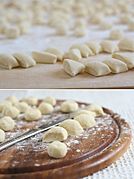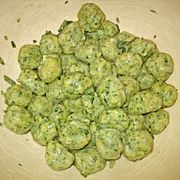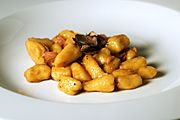Gnocchi facts for kids

|
|
| Type | Dumpling, pasta |
|---|---|
| Course | Entrée |
| Place of origin | Italy |
| Main ingredients | Potatoes, semolina, wheat flour, breadcrumbs; sometimes eggs, cheese |
| Variations | Cavatelli, gnudi, malfatti, malloreddus, strangulaprievete |
Gnocchi (/ˈn(j)ɒki/ N(Y)OK-ee, US also /ˈn(j)oʊki, ˈn(j)ɔːki/ n(y)oh-KEE-,_-N(Y)AW--, Italian: [ˈɲɔkki]; singular gnocco) are a varied family of dumpling in Italian cuisine. They are made of small lumps of dough most traditionally composed of a simple combination of wheat flour, egg, salt, and potato. Variations of the dish exist, where individuals often supplement the simple recipe with flavour additives, such as semolina flour, cheese, breadcrumbs, cornmeal or similar ingredients, and possibly including herbs, vegetables, and other ingredients. Base ingredients may be substituted with alternatives - sweet potatoes for potatoes or rice flour for wheat flour, as examples. Such variations are often considered to be non-traditional.
The dough for gnocchi is most often rolled out before it is cut into small pieces about the size of a wine cork or smaller. The dumplings may be pressed with textured object, such as a fork or a cheese grater to make ridges or cut into little lumps. Professional tools do exist for this purpose, known as a gnocchi board or a cavarola board. Gnocchi are usually eaten as a first course, but they can also be served as a contorno (side dish) to some main courses.
Gnocchi vary in recipe and name across different regions. For example, Lombard and Tuscan malfatti (literally poorly made) are made with ricotta, flour and spinach, as well as the addition of various other herbs if required. Tuscan gnudi distinctively contains less flour; but some varieties are flour-based, like the Campanian strangulaprievete, the Apulian cavatelli, the Sardinian malloreddus, and so on. Gnocchi are commonly cooked on their own in salted boiling water and then dressed with various sauces. But certain kinds are made of cooked polenta or semolina, which is spread out to dry, layered with cheese and butter, and baked.
Gnocchi are eaten as a first course (primo piatto) as an alternative to soups (minestre) or pasta. Common accompaniments of gnocchi include melted butter with sage, pesto, as well as various sauces. Gnocchi may be home-made, made by specialty stores, or produced industrially and distributed refrigerated, dried, or frozen. Most gnocchi are boiled in water and then served with a sauce. Small soup gnocchi are sometimes made by pressing the dough through a coarse sieve or a perforated spoon.
Contents
Origin
The word gnocchi may be derived from the Italian word nocchio, meaning a knot in wood, or from nocca, meaning knuckle. It has been a traditional type of Italian pasta since Roman times. It was introduced by the Roman legions during the expansion of the empire into the countries of the European continent. One ancient Roman recipe consists of a semolina porridge-like dough mixed with eggs; similar modern dishes include the baked gnocchi alla romana and Sardinian malloreddus which do not contain eggs.
After potatoes were introduced to Europe, they were eventually incorporated into gnocchi recipes. Potato gnocchi are particularly popular in Abruzzo, Friuli-Venezia Giulia, Veneto, and Lazio.
Manufacturing and packaging
Storing and packaging
Gnocchi that are home-made are usually consumed on the same day that they are made. However, they can be cut into bite-sized dumplings, spread evenly on a baking sheet, frozen, then packaged in an air-tight bag and back into the freezer for later consumption. This method can allow the gnocchi to last upwards of 2 months in the freezer.
Commercial gnocchi are often sold under modified atmospheric packaging, and may achieve a shelf life of two weeks or more under refrigeration. Some are sold in vacuum packaging that is shelf-stable, only needing refrigeration once it is opened.
Regional varieties
Gnocchi di pane (literally "bread lumps"), derived from the Semmelknödel, is made from breadcrumbs and is popular in Friuli-Venezia Giulia, Veneto and Trentino-Alto Adige/Südtirol. Another variety from the latter region is spinach gnocchi.
Austria
In Austria, gnocchi are a common main or side dish, known by the original name and Austrian variant, nockerl (pl. nockerln). As a side dish, they may accompany main dishes like goulash.
Croatia
Gnocchi are very popular and often served as a dish in coastal Croatia, typically being served as a first course or a side dish with Dalmatinska pašticada. The Croatian name for gnocchi is 'njoki'.
Slovenia
Gnocchi, known locally as "njoki", are common in Slovenia's Primorska region, which shares many of its culinary traditions with neighboring Italy.
Poland
An almost identical creation are 'kluski leniwe' ("lazy dumplings"), but these do not contain egg. Often they are seasoned with various spices like pepper, cinnamon or allspice. Similar in shape are kopytka ("hooves"), simple dough dumplings in the shape of a diamond, which do not contain cheese. Both are often served with sour cream, butter, caramelized onion, mushroom sauce, or gravy.
France
The name is also used in France in the dish known as gnocchis à la parisienne, a hot dish comprising gnocchi formed of choux pastry served with Béchamel sauce. A specialty of Nice, the gnocchi de tantifla a la nissarda, is made with potatoes, wheat flour, eggs and blette (Swiss chard), which is also used for the tourte de blette. La merda dé can is longer than the original gnocchi.
South America
Due to the significant number of Italian immigrants who arrived in Argentina, Paraguay and Uruguay, gnocchi, ñoqui (Spanish, [ˈɲoki]) or nhoque (Portuguese, pronounced: [ˈɲɔki]) is a popular dish, even in areas with few Italian immigrants. In Uruguay, Paraguay, and Argentina there is a tradition of eating gnocchi on the 29th of each month, with some people putting money beneath their plates to bring prosperity. Indeed, in Argentina and Uruguay ñoqui is slang for a bogus employee (according to corrupt accountancy practices, or, in the public sector, the distribution of political patronage), who only turns up at the end of the month to receive their salary.
Gallery
See also
 In Spanish: Ñoqui para niños
In Spanish: Ñoqui para niños




